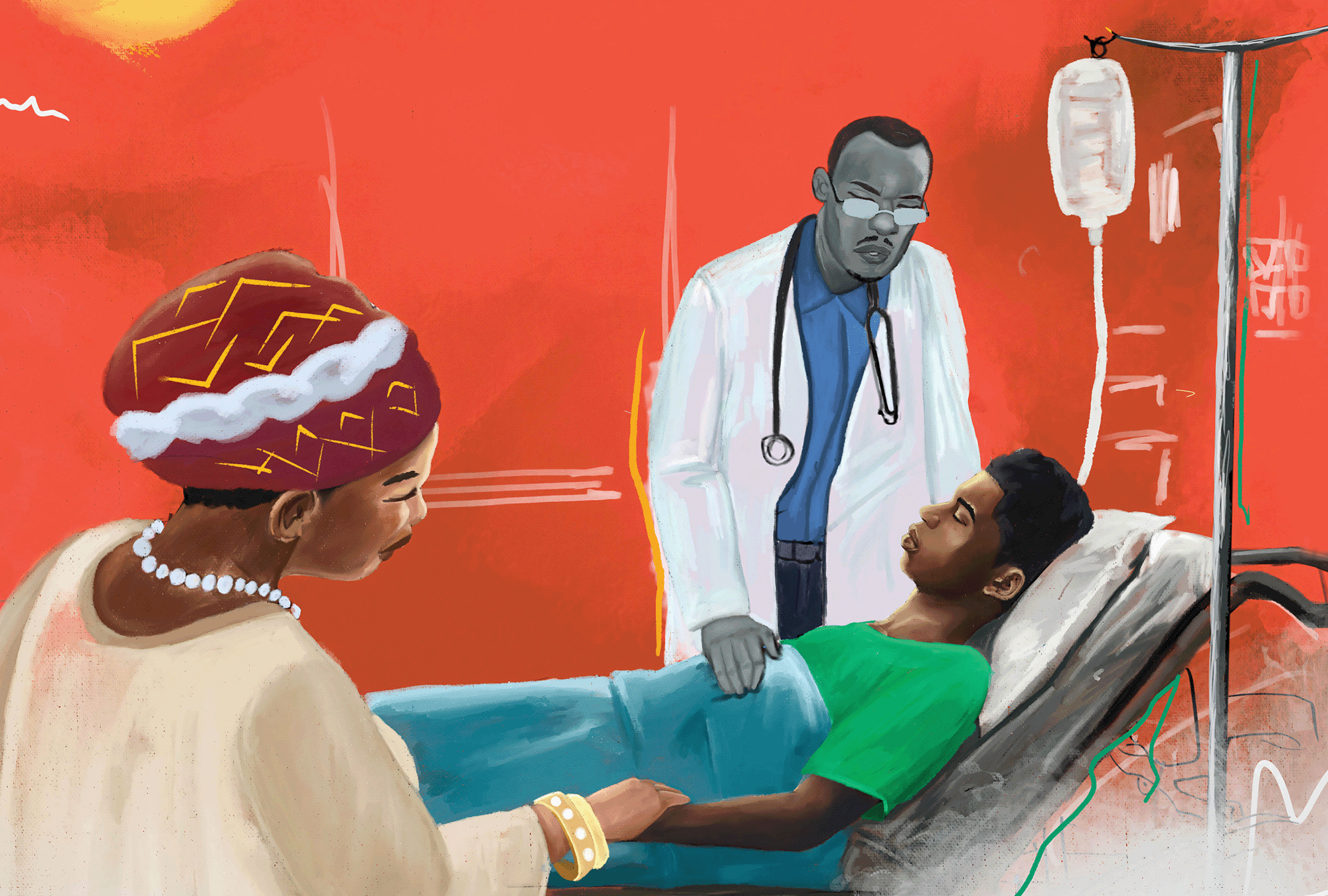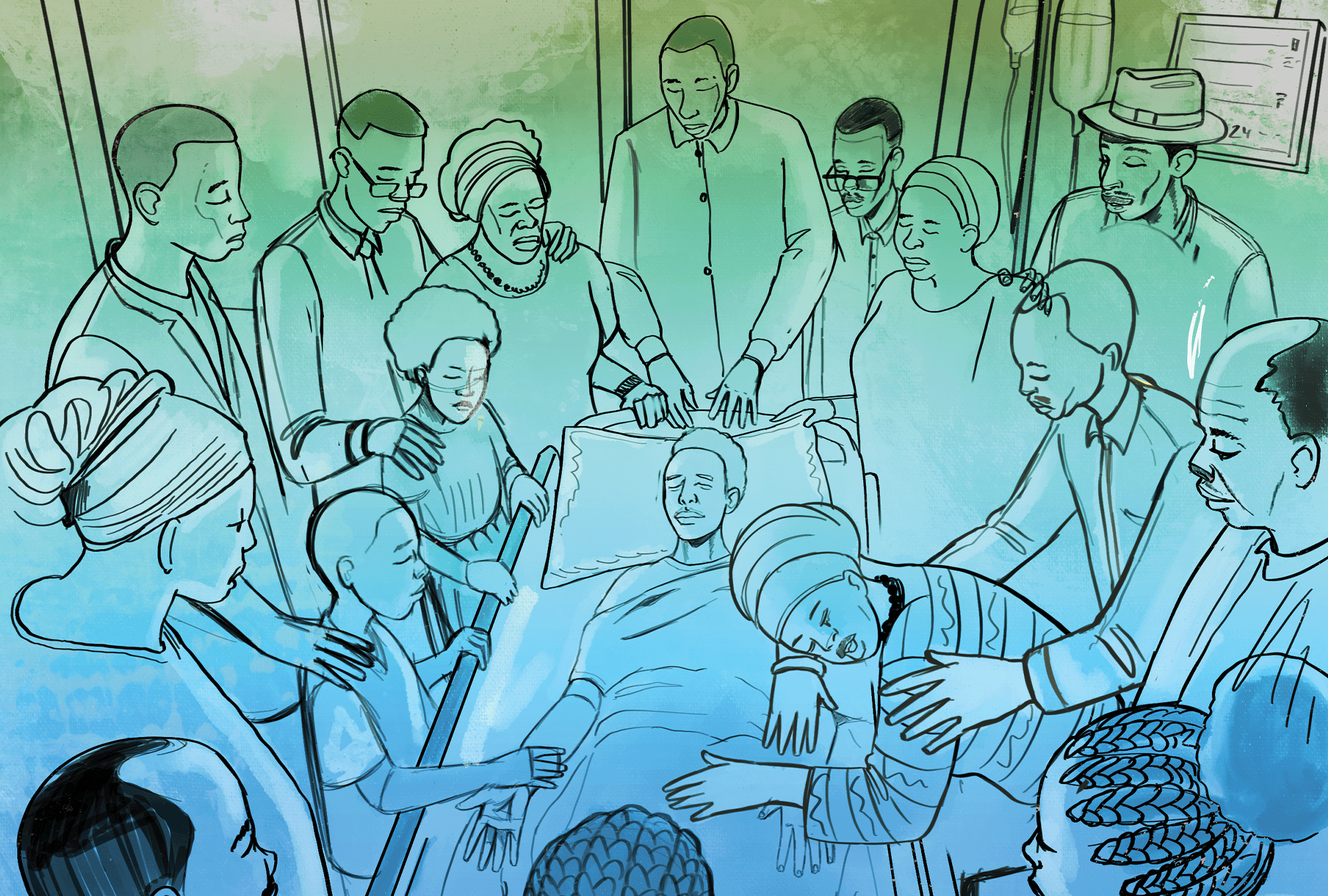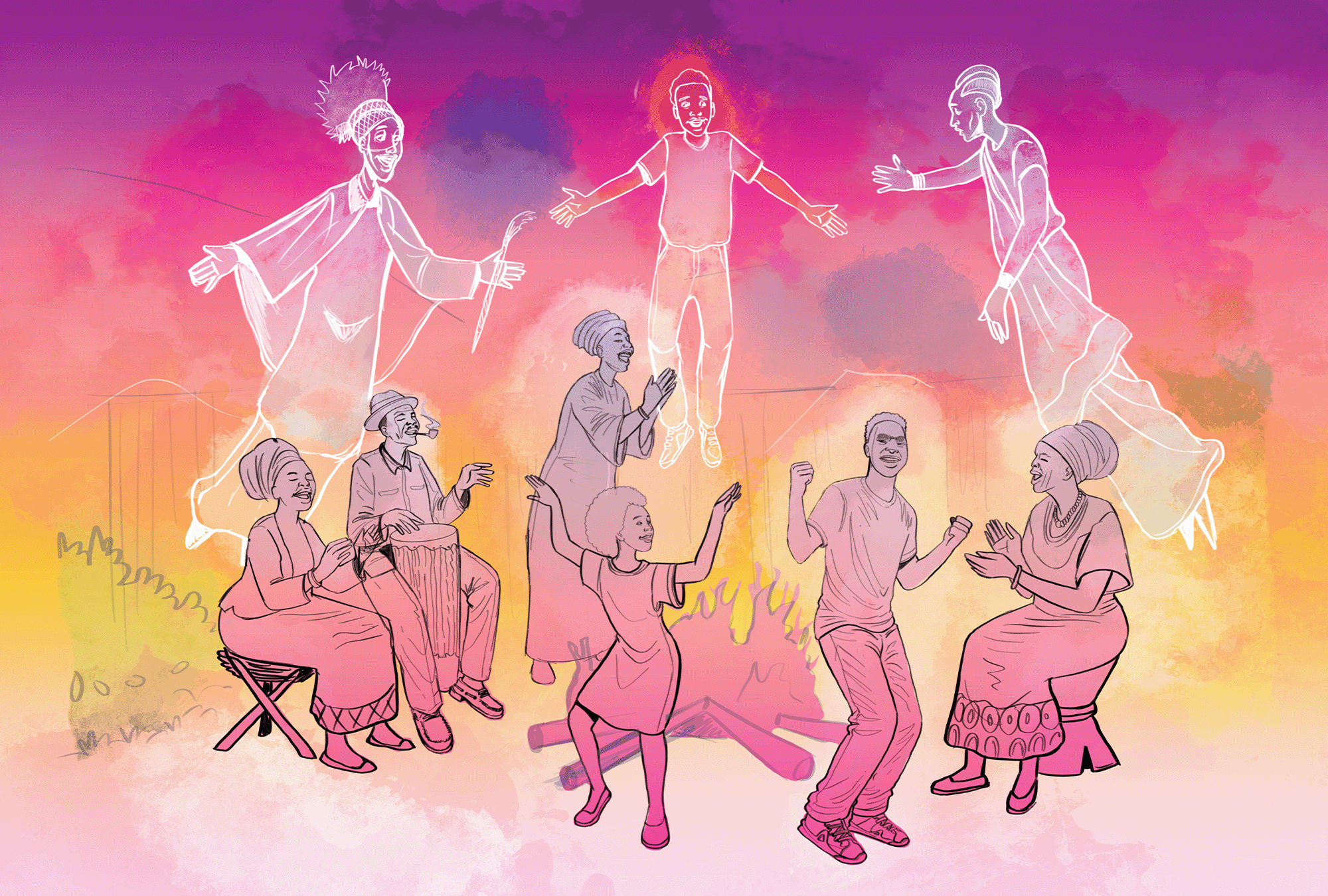Share As A Gift
Share a paywall-free link to this article.
This feature is only available for subscribers.
Start your subscription for as low as $4.95. Already a subscriber?

Illustrations by Kalima Alain
I LIVE IN Rwanda, a beautiful East African country also called the Land of a Thousand Hills. We have a saying here: “When you are well, you belong to yourself, but when you are sick, you belong to your family.” But my first trip to the United States taught me that culture matters, particularly in the context of end-of-life care.
In a palliative care education and practice course at Harvard Medical School, I learned the principle of patient autonomy — that individuals have the ultimate authority to make decisions about their own health care. Patients are “in control.” But while shadowing my mentor at Massachusetts General Hospital, I noticed photos of family members in patients’ rooms. I remember asking, “Where are the people who are shown in the photographs?” I now know that this may be an attempt to recreate a family or to provide a last chance to reconnect with life, but all the people I saw in the pictures were alive — why were people trying to create an illusion of family when the family exists?
I asked my mentor, “How can we bring back those people from the photos to the room?”
Of course, I came with my bias and an African perspective on end-of-life care. Here, decision-making is based on patient autonomy and community responsibility, because one aspect does not exclude the other. There is synergy between them.
In Rwanda, there are no photos in the patient’s room. Instead, there are people.
THIS YEAR, RWANDA commemorates 30 years since the genocide against the Tutsi. Some estimates hold that more than 1 million people died in just 100 days. During the genocide, I was living in my birthplace, the Democratic Republic of the Congo, but I witnessed the suffering in its aftermath. Hundreds of thousands of refugees moved to Goma, the Congolese city where my family and I lived, and tremendous chaos, including a cholera outbreak, soon followed. Shortly after the genocide, my family moved to Rwanda, deciding that it actually was safer than Goma. I remember seeing indescribable wounds, dead bodies, and health challenges to which I had never been exposed before. I was 15 years old.
This was profoundly challenging for me and prompted me to question my initial dream of becoming a pilot. I wanted to contribute to the alleviation of such suffering. Circumstances arose where my father’s business faced challenges, prompting him to suggest that I pursue medical school — it was locally accessible, and the Rwandan government provided scholarships to those who succeeded on the entry exam — with the option to reconsider once our financial situation improved. Flight school would have required me to move to Kenya or Uganda, and tuition fees and life expenses would have been less affordable than medical school. Reflecting on the proverb, “Many are the plans in a person’s heart, but it is the Lord’s purpose that prevails,” I came to understand that not attending flight school was part of God’s perfect plan for my life’s calling.
When I entered medical school, my aim was to become a surgeon. Since most of the cases I saw in hospitals and during medical school were surgery cases, I viewed surgery as an opportunity to contribute to the rebuilding of our country. After graduating, I was assigned to a district hospital as part of the Ministry of Health’s initiative to bolster the public health system. We were working to repair wounds, perform orthopedic surgeries, and attend to the physical consequences of the genocide. There, I encountered Rafiki, a 24-year-old diagnosed with advanced liver cancer. His harrowing ordeal compelled me to question my purpose.
Rafiki’s suffering was unlike anything I had encountered before. Despite his immense pain, I hesitated to prescribe morphine, fearing myths surrounding its use, such as the idea that morphine hastens death. Instead, he was only receiving weak opioids. Even when his mother desperately pleaded with me, kneeling before me, begging for something to ease her son’s pain and allow him to rest peacefully, I felt powerless.
Rafiki’s agonizing death in such horrific conditions became the catalyst for a profound shift in my perspective. What was the point of dedicating years to medicine if I couldn’t alleviate suffering at the end of life? Where was the humanity in witnessing people endure agony without intervention? It forced me to reconsider my path in life, though I wasn’t yet certain of the direction it would take.
During that time, Rwanda’s Ministry of Health arranged its first palliative care training. I attended with the intention of gaining insight into the suffering experienced by patients and their families. However, by the end of the two-week program, I realized that the focus had shifted from them to me. It was during this training that I began to comprehend my own experiences of suffering, leading to a deeper understanding of myself.
That marked the pivotal moment in my professional journey when I made the decision to shift my focus from surgery to becoming a palliative care physician. It felt like navigating from an abyss of suffering to an ocean of opportunities.
At the time, most people in Rwanda did not know that palliative care — an approach to improve the physical, psychological, and social quality of life for families and patients facing life-limiting illnesses — even existed. To many, particularly my colleagues, palliative care was often seen as — to use the language of the Apostle Paul in 2 Corinthians 2:16 — a “savor of death unto death,” given that these patients were already considered hopeless. However, for the patients and their families, I was a “savor of life unto life” amid the encroaching darkness. My presence offered a rekindling of hope when all seemed lost.
As my passion for palliative care deepened, it transformed into my true calling — a vessel through which I could serve the vulnerable, restore dignity, and uphold the principles of humanity.

Illustrations by Kalima Alain
I GREW UP in a Christian family, which shaped my values and ethics. In my book, The Safari Concept, I described a story I heard as a child about Anuarite Nengapeta, a Congolese Roman Catholic nun who was murdered by Simba rebels in the 1960s because she refused to become the wife of their leader. Sister Anuarite was imprisoned, beaten, and killed for her principles. Learning her story was the first time I remember learning about suffering. Although this incident was painful to imagine, I was impressed by her conviction. The suffering she endured was embedded in me from an early age.
When I became an adult, I started to attend evangelical churches where the gospel took a different perspective. There, faith needed to be seen in action, and death and life were intricately linked with sociocultural paradigms. The meaning of life was found through the death of Christ. As a Christian, a palliative care physician, and an African, I’ve found faith to be the most important thing I need when trying to bring equity and social justice for vulnerable people.
Rwanda predominantly consists of Christians (including Catholics, evangelicals, Adventists, Jehovah’s Witnesses, and Mormons); it also has a minority of Muslims and traditional practitioners. During my training in palliative care, I was profoundly impacted by the imperative to integrate spirituality into medical practice. In medical school, the training was notably secular, and spirituality was conspicuously absent from discussions, often perceived as incompatible with science — an assumption that proved misguided.
During my master’s program at Harvard Medical School, I conducted ethnographic research to understand why discussing death is a tough conversation in Rwanda. The concept of death has evolved over time, influencing how patients experience the end of their lives. I discovered that the introduction of Christian beliefs during the colonial period changed the paradigm of death and perspectives on the end of life. Prior to colonization, Rwandan tradition was unfamiliar with the concepts of hell and heaven. Death was regarded as an accomplishment in the pre-colonial era because it was a natural occurrence and part of daily life. It was also viewed as a prize for being a “spirit,” an “ancestor,” or a well-known family member. The ancestor was the family’s guardian. But death as punishment or condemnation increases fear and influences one’s perception of death during the dying process. The ceremony of “ancestors” became the ritual of “evil spirits.” Misguided, colonially influenced, Christian ideas added unique challenges to my work.
Death is an integral part of life, an entity inseparable from existence itself. Someone who accepts their mortality is also someone who fully embraces life. The key to living well is acknowledging that there is a physical end, even if there is not necessarily a spiritual end.
The Apostle Paul famously wrote, “For me, to live is Christ and to die is gain” (Philippians 1:21). In contrast to this ideal, I often witness religious individuals struggling to accept death. This seems contradictory, as they are taught that earthly life is temporary and that there is a permanent home awaiting them. Instead of fearing death as a punishment brought by the devil, it should be embraced as a transition to their eternal dwelling. It’s puzzling why their professed beliefs often seem at odds with acceptance when faced with the process of dying. Dying should be embraced with the same acceptance and anticipation as birth.
This is why I don’t see my role as a physician as simply a prescriber of medicine — physicians are reconcilers.
THE AFRICAN CULTURE is influenced by the Ubuntu philosophy, which emphasizes the connectedness of the individual with the community. “People are people through other people,” or, “I am, because you are.” The role of communication is crucial across diverse cultural and religious backgrounds. Ubuntu brings a balance between the modern and traditional through emphasizing dignity, compassion, harmony, and reconciliation.
I want to emphasize the reconciliation aspect of Ubuntu. From my experiences, when there is a life-limiting illness in a family, a psycho-social and spiritual fracture between the patient, their disease, their family, and the community automatically follows. In my practice, I use Ubuntu to reconcile the patient with their diagnosis, reconcile family and community with the patient through appropriate reengagement in support, and sometimes even reconcile families and their physician.
The word “reconciliation” has taken on an important meaning in Rwanda after the genocide. It was a process needed in the country to bring harmony between Rwandans. Unfortunately, in the medical field, this process is also often needed between patients and health care professionals. Part of this is an issue with training, availability, and accessibility: While most physicians in Rwanda are trained to treat acute diseases and illnesses such as the flu, malaria, tuberculosis, and appendicitis, some physicians disengage because they don’t know how to support people with chronic diseases. Often, treatments are not available, and when treatments are available, they often are inaccessible. This causes fractures.
But some fractures are driven by bad interpretation of the scriptures: I’ve seen situations where physicians exit a room to avoid receiving whatever bad spirits might leave a patient upon their death. Those myths behind death are incongruent with the understanding that the death of Christ is the source of life. Reconciliation, through education and right teaching, is important — death can be viewed as an accomplishment when physicians are present until the end.

Illustrations by Kalima Alian
MERELY BEING A Fulbright and Harvard alumnus isn’t sufficient to deliver effective palliative care to patients in Rwanda. This care requires careful observation and individualized attention to each patient, recognizing their unique backgrounds and life experiences.
Hippocrates, the ancient Greek physician and philosopher known as the father of modern medicine, emphasized, “It is far more important to know what person the disease has than what disease the person has.” This highlights the distinction between treating a disease and treating a patient. Addressing the disease alone means focusing solely on signs and symptoms, often neglecting compassion and empathy. In contrast, treating the patient involves acknowledging their dignity and ensuring that the disease is managed while caring for the individual’s overall well-being.
I’ve come to realize that the way people die can reflect how the society lives. Death and dying is not only a social event but a mirror that shows the realities of society. Providing palliative care in resource-limited countries poses significant challenges, stemming from issues of accessibility, service availability, and the stark realities faced by families who continue to support their loved ones despite unmet physical needs and financial constraints.
I recall the story of Clementine, a 37-year-old woman diagnosed with late-stage AIDS and cervical cancer. She lived in a small traditional mud house, where the door served as the window and vice versa. Sleeping on a simple carpet, she lacked adequate food and essentials. Upon encountering her for the first time, I was overwhelmed with emotion, unsure of where to begin. Addressing her physical needs seemed daunting, considering her body’s numerous deficiencies. The nursing staff initiated basic care, cleansing her and providing nourishment with the limited supplies we had brought. Clementine’s husband labored tirelessly, earning a mere $1 U.S. per day to support her, adding to the weight of our collective helplessness.
Witnessing such hardship while knowing our efforts fell short was deeply disheartening. Despite the ache in our hearts, we found solace in the knowledge that our presence offered a glimmer of hope to Clementine and her family. Although I often felt powerless in the face of their overwhelming needs, I found comfort in the belief that even the smallest gestures could make a meaningful difference. Below is a piece I composed when I was devastated by Clementine’s situation:
I’m a smell of death for some and a smell of hope for others.
I feel naked when I visit patients and family members in social,
psychological, and spiritual pain.
I cry in the palace of God because I don’t know where to start.
I feel naked when the dignity and value of patients are viewed
through the lens of their disease, not their humanity.
IN THE PAST few years, I’ve learned that vulnerability is essential in engaging the community and sharing responsibility. In Rwanda, to be vulnerable is a privilege, not a burden, because that is the way you open the space for community to be engaged. Vulnerability is not just for the patients, it is for health care professionals too: Being “human” shouldn’t be considered unethical in medical practice. In recent years, I made more of an impact on patients and their families by not hiding my vulnerability than by pretending to be able to control every step of the disease. Vulnerability doesn’t mean weakness but mainly the power of connection and limitation as a human being.
Health care professionals may not be able to bring the people from the photos into the room. But they can be there, themselves — and this can significantly impact people’s lives, sometimes more than by prescribing sophisticated treatment. I made the decision long ago not to attend every patient’s funeral, recognizing the importance of preserving my own emotional well-being. Each death brings its own process of grief, empathy, and spiritual reflection, and by allowing myself time for these internal journeys, I can continue to provide compassionate care — and my presence — to those in need. I’ve come to understand that faith plays a profound role in coping with adversity, echoing the sentiment expressed in Colossians (1:27): “Christ in you, the hope of glory.”
Got something to say about what you're reading? We value your feedback!